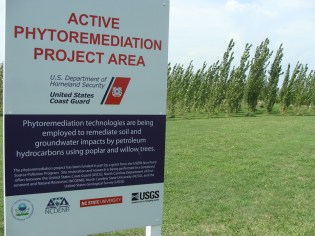Send your question to Umbra!
Q. Dear Umbra,
So cacti can remove selenium from soil. I’ve read in the past about different plants being able to “sop up” various nasty chemicals. My question is this: Then what? Are they to be harvested and dumped somewhere, so contaminating another piece of land, or are they allowed to live out their lives, die, keel over, and re-contaminate the same piece of land?
David B.
Greenfield, N.H.

Photo by Tommy Wong.
A. Dearest David,
Is there anything our plant friends can’t do? They look nice, they often smell nice, and they agreeably exchange their oxygen for our carbon dioxide. They sequester carbon, they feed us, they shade our homes, they shelter critters, they make indoor air cleaner, they improve worker productivity, they can be ground up to make medicines and teas. I could go on and on. Or maybe I couldn’t, because I’m getting all choked up just thinking about the sacrifices plants make for us, the dunderheaded humans who lurch among them.
And now we have the temerity to ask them one more favor: Hey plants, while you’re at it, could you clean up the contamination we have created in the course of our brash modern lives? We seem to have left just a few splotches of pesticides, oil and gas, solvents, heavy metals, and radionuclides here and there. Mind absorbing those from the soil and groundwater?
Yes, say the plants obligingly. Just tell us where to go and what to do.
So we ask them to engage in phytoremediation, a process by which plants absorb contaminants into their roots, stems, and leaves. But we shouldn’t feel too sorry for our leafy friends, says USGS research hydrologist Jim Landmeyer, who has recently written a textbook on the topic: “Plants have been exposed to all sorts of nasties for the last 400 million years. They’ve figured out how to survive all that, and they’ve been endowed with the ability to clean up some of the things we’ve spilled.”
Landmeyer says the modern notion of phytoremediation took hold in the mid-1970s, thanks to the work of USDA researcher Rufus Chaney, and has been actively researched and applied since the early 1990s. As a clean-up method it’s fairly effective, it’s cheaper and less labor-intensive than options such as excavating soil, and it’s a mite prettier than a bulldozer. It also ideally leaves fertile soil behind so other plants can happily grow.
A thorough cleanup can take years, requiring several rounds of crops. In the case of heavy metals, plants known as hyperaccumulators absorb and store the offending substances until harvest day comes. When the contaminant in question is an organic compound such as gasoline, the plants are generally able to break it down into less potent forms, which they store or release.

Photo by Elizabeth Guthrie Nichols.
Which plants are best suited for this job? Super-suckers include willow, poplar, ragweed, sunflowers, mustards, and some grasses. Certain genetic modifications can make them even … suckier. And these leafy overachievers, natural and modified, are in action all across the country, from the selenium-filled deserts of California to lead-addled backyards in Boston. The process has been embraced by the government — which has tested it at various places including more than 200 Superfund sites and continues to research its broader applications — and by some biotech and remediation companies too.
When the plants have done their job, they are harvested, and considered hazardous biomass. They are usually compacted, since they’re so squishable, then either sent to a landfill or burned. Ish, you’re thinking. What good is removing contamination from the soil if we just put it back in the ground or in the air? Good question. In theory, carefully constructed landfills and incinerators limit the release of harmful contents. Plus, the squished plants take up far less room than acres of excavated soil. Meanwhile, we have returned a contaminated area to sustainable growing conditions, or to a potential location for a new gas station.
Two possible economic side benefits to the incineration situation: This harvested biomass can be burned to create energy, and often is in Europe, says Landmeyer. And sometimes, in an operation known as phytomining, the heavy-metal ore is retrieved from the plants’ ashes, then recycled or resold.
There you have it, David. All your phytoremediation questions answered. It’s not a perfect process, but so far it looks better than many alternatives. So next time you see a cactus that looks like it’s just idly standing by, give it a nod for taking on one of the dirtiest jobs around.
Hyperaccumulatingly,
Umbra



